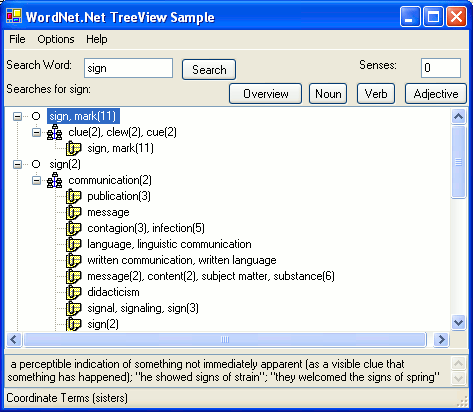WordNet.net
WelcomeWelcome to the home page for the WordNet.Net library - the .Net Framework library for WordNet. The initial source release was on 6 June 2005. This library is maintained and managed by Troy Simpson. Malcolm Crowe is the author of the legacy library code which is now superceded by several WordNet database versions and library enhancements/bug fixes.
Journal and article writers, please reference the WordNet library as: Simpson T., Crowe M., 2005, WordNet.Net http://www.ebswift.com/wordnetnet.html |
DOWNLOAD
- Download WordNet.Net for WordNet 3.0 from this github repository: https://github.com/ebswift/wordnetdotnet
REQUIREMENTS
WordNet.Net Project, Article and Journal Citations
My work on the WordNet.Net library has been cited in the following publications and projects:
Note that references vary, but ALL references that refer to this site or have used the library called WordNet.Net from 2005 onward is my rewrite of Malcolm's original work and therefore is relevant to this site and can be attributed to both Malcolm and myself. A number of publishers have taken my work without proper referencing.
- Microsoft .Net Framework
- Microsoft Visual Studio or SharpDevelop
WordNet.Net Project, Article and Journal Citations
My work on the WordNet.Net library has been cited in the following publications and projects:
Note that references vary, but ALL references that refer to this site or have used the library called WordNet.Net from 2005 onward is my rewrite of Malcolm's original work and therefore is relevant to this site and can be attributed to both Malcolm and myself. A number of publishers have taken my work without proper referencing.
- Seamlessly integrating service discovery into UML requirements processes
- WordNet-based semantic similarity measurement
- Multidisciplinary Information Retrieval
- MultiMedia Modeling
- Database Systems for Advanced Applications
- SharpNLP
- Increase the efficiency of English-Chinese sentence alignment: target range restriction and empirical selection of stop words
- A new unsupervised method for document clustering by using WordNet lexical and conceptual relations
- Automatic Prediction of Item Difficulty Based on Semantic Similarity Measures
- Ontology Based Semantic Integration of Heterogeneous Geographical Information Systems
- Personalizing Entity Detection and Recommendation with a Fusion of Web Log Mining Techniques
- Automation of webpage quality determination
- Concept-Based Semantic Annotation, Indexing and Retrieval of Office-Like Document Units
- Mining API Mapping for Language Migration
- The semantic component library system expansion with ontology reasoning
- Semantic memory as a basis for Control chatterbot
- Sentence and Word Alignment of English-Chinese Paragraphs with Lexical Translations
- A Tool for Semantic Integration of Geographic Ontologies
- Discovering Web Services to Specify More Complete System Requirements
- TWET Web Mashup
- Draw Me a Storyboard: Incorporating Principles and Techniques of Comics to Ease Communication and Artefact Creation in User-Centred Design
- VisualBee
- A Frequent Concepts Based Document Clustering Algorithm
- Using Filtered Second Order Co-occurrence Matrix to Improve the Traditional Co-occurrence Model
- ai8ball Question & Answer System
- Using WordNet-based semantic similarity measurement in External Plagiarism Detection
- Ontology-based annotation recommender for learning material using contextual analysis
- Regression Test Selection Techniques for Test-Driven Development
- SRL-GSM: A Hybrid Approach based on Semantic Role Labeling and General Statistic Method for Text Summarization
- A Multi-level Disambiguation Framework for Gene Name Normalization
- Clustering of Web Services Based on Semantic Similarity
- Similarity Used In The Identification Of The Need To Refactoryze An Ontology
- ASKME: Adaptive and Self-evolving Knowledge-base for Mobile Environments
- Multi-document extraction based Summarization
- Semantic-Based Grouping of Search Engine Results
- QASYO: A Question Answering System for YAGO Ontology
- Discovering Remote Software Services that Satisfy Requirements: Patterns for Query Reformulation
- Textual Similarity: Comparing texts in order to discover how closely they discuss the same topics
- Mapping Persian Words to WordNet Synsets
- Finding Related Micro-blogs Based on WordNet [mentioned by name in text, not in references]
- OntoCompare: Assertion Based Comparison of Ontologies on the Semantic Web
- Semantic Web: Ontology and Knowledge Base Enabled Tools, Services, and Application
- Accepting Inferred Student Solutions by Tutoring System in an Ill-Defined Domain
- Education Based Semantic Search Engine Using Web Services
- Enriching WordNet for Word Sense Disambiguation
- Measuring the sentence level similarity
- Ontology-based Annotation Recommender for Learning Material Using Contextual Analysis
- Enhancing Web Search with Semantic Identification of User Preferences
- Analyzing Sentiment while Accounting for Negation Scope and Strength
- A Registry Based Discovery Mechanism for E-Learning Web Services> [references WordNet.Net 2005 which aligns with the date of my initial release]
- Searching Documents with Semantically Related Keyphrases
- Application of Heuristic-Based Semantic Similarity Between Single-Topic Texts for the LSAT
- Image Labeling and Classification by Semantic Tag Analysis
- In Other Words: Expanding Queries with WordNet
- Sentiment Lexicon Creation from Lexical Resources
- Community Answer Summarization for Multi-Sentence Question with Group L1 Regularization
- R2Sim: Novel Semantic Similarity Measures for Matching between RDF Ontologies
- Hybrid Web Service Selection by Combining Semantic and Keyword Approaches
- Improved TF-IDF Ranker
- Assessing Students' Answers to Open Questions
- Task-Driven Image Retrieval Using Geographic Information
- Training inter-related classifiers for automatic image classification and annotation
- Auto-Assessor: Computerized Assessment System for Marking Student's Short-Answers Automatically
- Measuring Similarity Between News Items Using Link Analysis and Semantic Approach
- On the Role of Semantics in Automated Requirements Tracing
- Creativity Support to Improve Health-and-Safety in Manufacturing Plants: Demonstrating Everyday Creativity
- "Bully": A Virtual Reality Environment for Anti-Bullying Education
- Automated Scoring for Essay Questions In E-learning
- Arabic Semantic Similarity Approaches – Review

